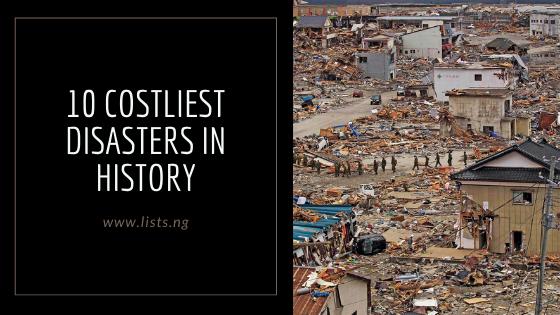Disasters cause widespread human, material, economic or environmental loss which often exceed the ability of the affected community or society to cope using its own resources. Africa has been fortunate to experience less disasters compared to the rest of the world, but for those that experience it, the destruction often results in high costs associated with responding to and recovering from them.
Below are the 10 costliest disasters in history.
1. 2011 Tōhoku earthquake and tsunami
Total damage: $360 billion
A magnitude 9.0–9.1 undersea megathrust earthquake hit Tōhoku, Japan at 14:46 JST on Friday 11 March 2011. It was the most powerful earthquake ever recorded in Japan, and the fourth most powerful earthquake in the world since 1900.The earthquake triggered powerful tsunami waves that may have reached heights of up to 40.5 meters (133 ft). The tsunami swept the Japanese mainland and killed over 15,000 people. The World Bank’s estimated economic cost was US$235 billion, making it the costliest natural disaster in history
2. Great Hanshin earthquake
Total damage: $200 billion
The magnitude 6.9 earthquake occurred on January 17, 1995 at 05:46:53 JST in the southern part of Hyōgo Prefecture, Japan, including the region known as Hanshin. Up to 6,434 people lost their lives. This was Japan’s worst earthquake in the 20th century after the Great Kantō earthquake in 1923, which claimed more than 105,000 lives.
3. Sichuan earthquake
Total damage: $150 billion
The 2008 Sichuan earthquake, also known as the Great Sichuan earthquake was the deadliest and costliest natural disaster to strike China. The magnitude 8.0 earthquake occurred on May 12, 2008, causing over 69,000 deaths and $150 billion in damages. Around 374,176 were also reported injured, with 18,222 listed as missing as of July 2008.
4. Hurricane Katrina
Total damage: $125 billion
Hurricane Katrina was a Category 5 tropical cyclone that occurred in August 2005, which caused over 1,200 deaths and $125 billion in damage, particularly in the city of New Orleans and the surrounding area. flooding destroyed most of New Orleans’ transportation and communication facilities, leaving tens of thousands of people who had not evacuated the city prior to landfall stranded with little access to food, shelter or basic necessities. The scale of the disaster provoked massive national and international response efforts; federal, local and private rescue operations evacuated displaced persons out of the city over the following weeks.
5. Hurricane Harvey
Total damage: $125 billion
Hurricane Harvey was a devastating Category 4 hurricane that hit Texas and Louisiana in August 2017, causing calamitous flooding and deaths. The disaster cost $125 billion in damage, primarily from catastrophic rainfall-triggered flooding in the Houston metropolitan area and Southeast Texas. It was the first major hurricane to make landfall in the United States since Wilma in 2005. The resulting floods inundated hundreds of thousands of homes, which displaced more than 30,000 people and prompted more than 17,000 rescues. The disaster caused at least 107 confirmed deaths: 1 in Guyana and 106 in the United States.
6 Hurricane Maria
Total damage: $91 billion
Hurricane Maria was a catastrophic Category 5 hurricane that devastated Dominica, St Croix, and Puerto Rico in September 2017. It is regarded as the worst natural disaster in recorded history to affect those islands and was also the deadliest Atlantic hurricane since Jeanne in 2004. At its peak, the hurricane caused catastrophic destruction and numerous fatalities across the northeastern Caribbean. Total losses from the hurricane are estimated at upwards of $91.61 billion, mostly in Puerto Rico, ranking it as the third-costliest tropical cyclone on record.
7. Hurricane Sandy
Total damage: $69 billion
Hurricane Sandy was the deadliest and most destructive, as well as the strongest, hurricane of the 2012 Atlantic hurricane season. The hurricane inflicted nearly $70 billion in damage and became the largest Atlantic hurricane on record. At least 233 people were killed along the path of the storm in eight countries.
8. Hurricane Irma
Total damage: $65 billion
Hurricane Irma was a Category 5 hurricane in Cape Verde that caused widespread destruction across its path in September 2017. It was the most intense hurricane to strike the continental United States since Katrina in 2005, the first major hurricane to make landfall in Florida since Wilma in the same year, and the first Category 4 hurricane to strike the state since Charley in 2004.
9. Deepwater Horizon oil spill
Total damage: $60 – $100
The Deepwater Horizon oil spill was an industrial disaster that began on April 20, 2010, in the Gulf of Mexico on the BP-operated Macondo Prospect, considered to be the largest marine oil spill in the history of the petroleum industry. The U.S. federal government estimated the total discharge at 4.9 million barrels. After several failed efforts to contain the flow, the well was declared sealed on September 19, 2010. Due to the months-long spill, along with adverse effects from the response and cleanup activities, extensive damage to marine and wildlife habitats and fishing and tourism industries was reported The Deepwater Horizon oil spill is regarded as one of the largest environmental disasters in American history.
10. 1988–89 North American drought
Total damage: $53 billion
The North American Drought of 1988 was a multi-year drought that began in most areas in 1988 and continued into 1989 and 1990. The heat waves killed 4,800 to 17,000 people in the United States. The drought caused $53 billion in damage. During the spring, several weather stations set records for the lowest monthly total precipitation and the longest interval between measurable precipitation. During the summer, two record-setting heatwaves developed, similar to those of 1934 and 1936. At its peak, the drought covered 45% of the United States. The drought of 1988 ranks as not only the costliest drought in United States history but also one of the costliest natural disasters in United States history.



